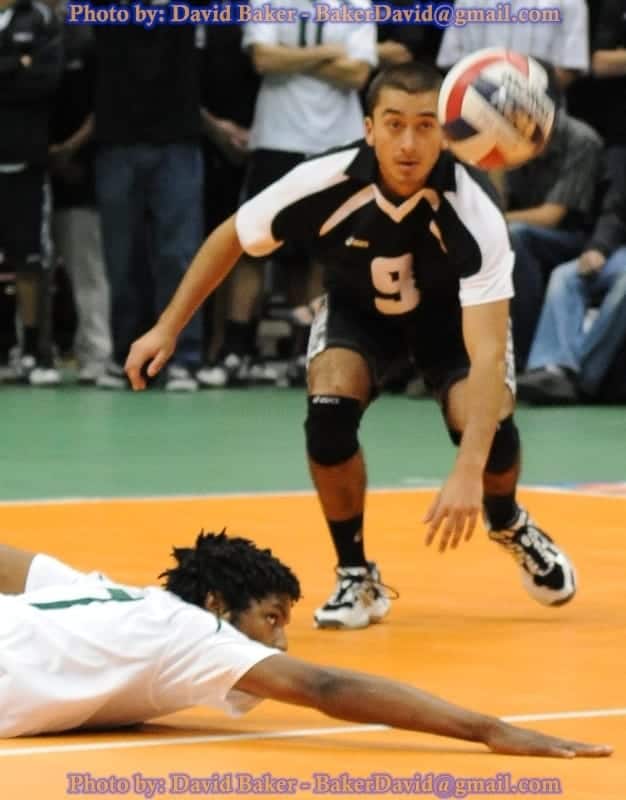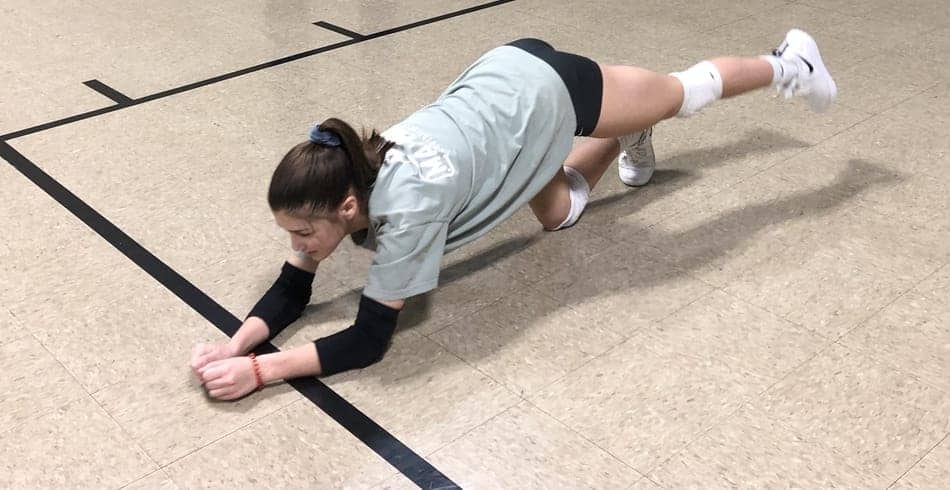In volleyball, there are many different variations of random and rare hits. While many are simply nameless desperation hits, some of these have a specific name that identifies them because they are so unique.
So what is a pancake in volleyball? The pancake is a one-handed dive dig that’s a last ditch effort to keep the ball in play.

The pancake is a very specific dive and players should master sliding and diving before progressing to try this particular move. At a competitive level, all players should have this move in their arsenal.
Why Would You Do a Pancake?
You never want to do a pancake, it’s an absolute last resort. There are 2 very good reasons you will not look forward to using the pancake: it hurts and it very rarely works. Getting the pancake takes guts, but when it works, you will gain the heart of your teammates, the respect of your coach and the awe of your fans!
Players should practice doing a pancake dive if they play on a competitive team just so they know how to execute an attempt if it’s ever needed. Just like other dives and slides, it can be very painful and even result in injury if you don’t do it right.
With a little practice, you can limit the damage to minor temporary discomfort. While you may expect the libero or defensive specialists to be the ones doing this kind of move, anyone who wants to win may have to go for it from time to time.
There are a couple of reasons it very rarely works:
- First, it’s very difficult to get a good hit. Your timing has to be close to perfect in a desperate situation.
- Second, the hit will be pretty unpredictable in both direction and height.
- Third, even when you do everything right, often your teammates will not expect the ball to still be in play and simply be too shocked to play the ball! Keep reading to find out how to change that in a split second.

When To Do a Pancake?
This is a rare situation we’re discussing. You may play a whole season and never be put in the right situation to perform a pancake dive. This is when the ball is so far out of reach you won’t make it there even with a normal good dive.
When the ball is just out of reach ahead of you, a quick step or a normal dive will give you a much better chance of playing the ball with a good clean pass. The pancake is for when there’s a surprise tip that catches you off-guard or a net serve that just drops on your side of the net. When there’s no way to cover that much ground, and the ball is dropping fast, that’s when you go for the pancake!

How to Execute a Pancake
- You will usually be starting in your defensive stance, ready to receive or dig.
- Step forward with your non-dominant foot (for most players this is your left foot), preparing for a dive.
- If you see that the dive will not get you far enough, let your body fall further toward the ground.
- Drive yourself forward, HARD right before you would hit the ground. You want to avoid diving upward at all, you’re looking to transition your momentum from down to forward. It’s going to hurt less, the lower you can get to the ground.
- Reach out your dominant hand in a one-armed superman dive. Keep your palm down facing the ground. Plan to slide. Sometimes you will reach it without sliding, but other times you will have to slide to make it to your target.
- Try to time it so that your hand slaps the ground right on the spot where the ball would land, right as the ball makes contact. This is critical. You are not swinging at the ball, the way that the ball has enough force to bounce up, is by hitting your hand just as it is planted on the ground. If you time this wrong, it will simply flop away.
- Immediately call to your teammates – “Help!”, “Play It!” or “Ball’s Up!” Many times they will be surprised and may hesitate just a second too long. Calling to them will help them respond quicker. Also, by calling out like this you’re announcing to the ref that you just made a solid hit. Sometimes it will be difficult for the ref to see what just happened and by calling out like this, you can give them the assurance to let the play continue.
- Get up, out of the way and ready! So you got the save, but your teammates can’t play the ball with you laying all over the middle of the court. Get up, rolling out of your slide in the direction away from the nearest player if possible. This helps your teammates play the ball and gets you ready to finish strong in winning this point!

Teaching and Practicing the Pancake
So if you’re ever going to use this in a game, you should probably practice it at least a few times at game speed. You will increase the likelihood of success and greatly lower the chance of getting hurt. Teaching this move in progression will help greatly. Coaches can take smaller progressive steps if needed, depending on player level.
Phase One of Learning the Pancake:
Begin in pairs with one ball. One player drops the ball to their partner nearby who quickly crouches and practices making the pancake contact with the ball as it’s about to bounce. Players should not be diving here, they need to focus on how their hand plays the role of making the ball pop back up by timing the bounce. Practice until each player can perform 5 well-hit saves in a row.
Phase Two of Learning the Pancake:
Next, have the partners separate a few steps and have the tosser lob the ball. Again the receiver should be in a crouch or on one knee and work on tracking the ball through the air and learning to consistently get the kind of contact that makes the ball playable. Again practice until each player can produce 5 good saves.
Phase Three of Learning the Pancake:
Finally, make this as realistic as possible. The coach or teammate is at the net and simulates a tip. This can be while standing on a hitting box or chair.
The player will start out deep in the court. It’s important that the tip will be so short there’s no possible way the player can reach it without doing a pancake. This should probably be at least 5 paces from where you start out.
Because you know it’s coming you can take multiple steps, just make sure you are stepping with your opposite foot and reaching out with your dominant hand as you dive. Some advanced players will use the opposite hand, but honestly, that’s making one of the most challenging saves in volleyball just a whole lot harder.
Related Questions
What Is a Dig in Volleyball?
A dig in volleyball is the defensive hit that prevents the ball from hitting the floor after a downward attack. When one team attacks with a hit, the other team’s defensive players have to anticipate the area they are hitting to and be ready to save the ball and pass it back into play.

While this is intimidating and may seem impossible to new players, it’s a learned skill. With practice, defensive specialists and liberos can become incredibly consistent and digging.
To learn all about digging in volleyball, check out our article called What Is A Dig In Volleyball? Lessons, Drills, And Techniques.
What Is a Shank in Volleyball?
A shank in volleyball is a mishit that makes the ball completely unplayable. These are usually mishits that go wild to the side or behind the receiver. When you hit a shank, that usually means your team just gave up the point.
To learn all about shanks and how to avoid them, check out our article called What is a Shank in Volleyball?
Photo credits:
Players #7 and #9 image by David Baker on flickr.com: https://creativecommons.org/licenses/by-nd/2.0/
“Dive Gone Bad” image by Bugeater on flickr.com: https://creativecommons.org/licenses/by/2.0/
Blue player pancake image by popo.uw23 on flickr.com: https://creativecommons.org/publicdomain/zero/1.0/
Dig image by Dan Morgan on flickr.com: https://creativecommons.org/licenses/by/2.0/ – cropped to adjust the size.
Recent Posts
Athletes, listen up! Do you have a closet full of old jerseys, sweatpants, and tees that you just can't seem to part with? Well, dust them off, because you're sitting on a goldmine of fashion...
You may have heard, or you may have noticed, that there's been a change to the rule about double contact in volleyball. In 2022, an experimental rule change began to be implemented, where the double...
